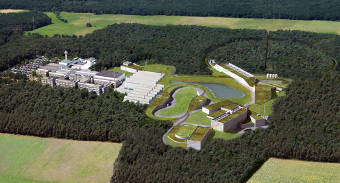
Over a hundred European researchers meet this week in Valencia to debate the first steps fro the future European reference installation to research on nuclear physics, the FAIR laboratory, which is being built in Darmstadt (Germany). The NUSTAR week 2014 takes place from 22 to 26 September in the IFIC venue (Institute of Corpuscular Physics) at the Science and Technology Park of the University of Valencia.
This scientific encounter addresses the launch of this experimental installation which will research on the process of formation of the heaviest elements in the Universe, among other topics.
NUSTAR’s collaboration (Nuclear Structure, Astrophysics and Reactions) is one of the ‘four pillars’ of FAIR whose objective is to understand how heavy metals are formed in the Universe, all heavier than iron. These elements are produced in violent events such as supernova explosions in a process known as ‘r-process’, a process which happens with extreme temperature and density conditions. With NUSTAR’s particle beam, exotic nuclei created in this type of phenomenon will be produced in order to give rise to the heavy stable elements we see nowadays.
In the meeting which will take place at the Institute for Corpuscular Physics, NUSTAR researchers (a collaboration with over 700 scientists and 170 institutions from all over the world) will start defining the launch of different experiments for the project once the laboratory which will be home for them (FAIR) opens in 2018. NUSTAR is made up of a series of detectors that will take advantage of the exotic nuclei produced by Super-FRS, the world biggest installation to produce this type of nuclei (which are not stable and hence are not found in Nature) to ‘relativists’ energies.
There is an important Spanish participation in many of these NUSTAR detectors each of them specialized in one concrete aspect of the physics aimed to be studied (as it occurs with the Large Hadron Collider, LHC). Nuclear physics experimental groups have been collaborating for over a decade in the preparation of these detectors. These university groups are: University of Santiago de Compostela (USC), Politècnica de Cataluña (UPC), Granada (UGR), Huelva (UHU), Sevilla (US) and Vigo in collaboration with he IEM-CSIC (Institute of Matter Structure). Over 50 Spanish nuclear physicists will participate in FAIR.
This collaboration has already started to bear its fruits. Berta Rubio, IFIC researcher and Spanish representative in the FAIR organ who evaluates each countries’ contribution, reminds that there are five devices lead by Spanish groups fro the FAIR/NUSTAR who have passed their design’s approval. Two of them have already been used at other facilities, waiting for FAIR’s ending: BELEN, designed by the UPC and installed at the German GSI laboratory and DTAS, lead by IDIC and proved in the nuclear physics venue IGISOL in Finland.
CALIFA (on of the detectors from the R3B experiment headed by the University of Santiago de Compostela) and MONSTER (spectrometer lead by CIEMAT) are testing their ‘demonstrator’ prototype while MATS, device to measure the average live of exotic nuclei is testing the trap to catch the nuclei, important part of the Spanish contribution as explained by the spokesperson Daniel Rodríguez, researcher from the University of Granada.
Overall, Spanish groups contribution to NUSTAR instrumental is of around 2.000.000 Euros, although Spain is not officially a part of the consortium that builds FAIR (included countries: Germany, Slovenia, Finland, France, India, Poland, Romania, Russia, Sweden and Great Britain. However, according to Berta Rubio and Dolores Cortina, the event’s coordinators, both the contribution of the experiments that will take place at the FAIR and the celebration of this encounter in Spain support the importance of the Spanish scientific community within the project, called to become the reference laboratory in Europe for nuclear physics research.
Among the assistants to the meetings there are directors from diverse European installations such as SPIRAL2 or Orsay’s Nuclear Physics Institute (both in France) as well as the president of the NUSTAR collaboration Kalanta- Nayestanaki (University of Groningen, Holland) and FAIR’s deputy director Inti Lehmann. For the organization of this congress, IFIC counts with the support of the CPAN (Comprehensive Perl Archive Network), Consolider-Ingenio 2010 project.
Valencia in NUSTAR
The Institute of Corpuscular Physics (IFIC, CSIC-UV) is one of the Spanish groups with the greatest weight at the European installation of nuclear physics FAIR. Added to the presence of researcher Berta Rubio at NUSTAR’s Resource Board, organ which assesses each country’s contribution to the project, the scientific contribution by the Valencian research center is important.
The group of Neutrons and Gamma Spectroscopy Group has developed a new detector coordinated by José Luis Taín to measure beta disintegration, DTAS. Its success was proven with success at the Finnish nuclear physics installation IGISOL. Additionally, the IFIC contributes to the BELEN and MONSTER detectors, which will be a part of the HISPEC/DESPEC (one of the NUSTAR experiments). The spectrometer AGATA will also be used in the installation; it is a tool developed by a European collaboration in a project currently directed by the IFIC researcher Andrés Gadea.
+Info: http://indico.gsi.de/index.py
Last update: 22 de september de 2014 13:07.
News release



















